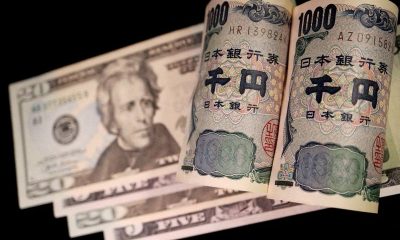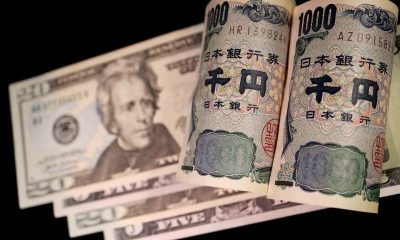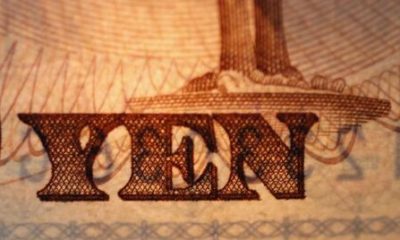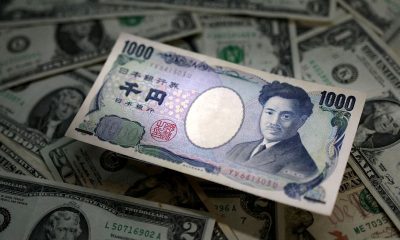Forex
Asia FX skittish, dollar at 4-mth low before key inflation data

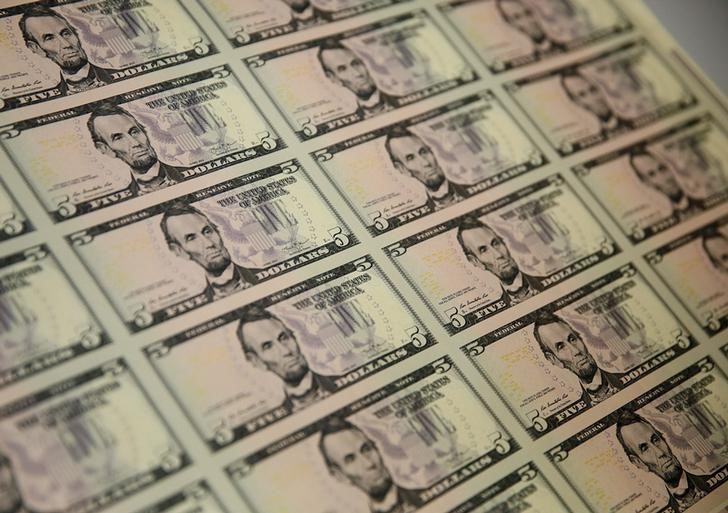
© Reuters.
Investing.com– Most Asian currencies kept to a tight range on Friday, while the dollar hovered around four-month lows as markets awaited more affirmation that the Federal Reserve will cut interest rates earlier in 2024.
Regional units were sitting on some gains this week, while the dollar was set for a second week in red after dovish signals from the Fed saw traders pricing in between three to five rate cuts by the central bank in 2024.
But gains in Asian currencies were held back by uncertainty over the timing of the cuts, especially as several Fed officials pushed back on expectations that monetary easing from the central bank was imminent.
Japanese yen retreats on soft inflation data, BOJ uncertainty persists
The was among the bigger underperformers for the day, falling 0.3% after data showed that inflation eased as expected in November. The currency was also set for a 0.2% weekly loss.
hit a 16-month low as a cooling Japanese economy saw spending decrease, while easing food prices also helped.
But the inflation reading pointed to lesser pressure on the Bank of Japan to consider pivoting away from its ultra-dovish policy, given that high inflation was a key point of contention for the central bank. November’s readings were still well above the BOJ’s 2% annual target.
While the central bank is still expected to reverse its ultra-dovish stance in 2024, the softer inflation reading brings more uncertainty over the timing of the move. The BOJ offered scant cues on a pivot during its meeting earlier this week, which battered the yen.
Broader Asian currencies traded in a flat-to-low range as traders turned cautious before key U.S. inflation data due later in the day.
The fell 0.3%, retreating slightly from a near five-month high hit in the prior session. The currency was also set to add 1.3% this week, as it benefited from improving risk appetite in the wake of a dovish Fed.
The rate-sensitive shed 0.3%, while the remained pinned near record lows of over 83 against the dollar.
The continued to lag its peers, losing 0.1% Friday and heading for a 0.4% weekly loss. Concerns over a sluggish economic rebound in the country kept traders largely wary of investing in most Chinese assets, with stocks bearing the brunt of this aversion.
Dollar at 4-mth low with PCE inflation in focus
The and moved little in Asian trade on Friday after sinking to their weakest levels since early-August.
A slight downward revision in third-quarter saw traders grow more optimistic over interest rate cuts in 2024, although the reading still reflected strong growth in the U.S. economy.
Focus was now squarely on data- the Fed’s preferred inflation gauge- due later on Friday. The reading is expected to show persistent stickiness in U.S. inflation- a scenario that gives the Fed more impetus to keep rates higher for longer.
U.S. inflation is still trending well above the Fed’s 2% annual target, with any more signs of stickiness pointing to less dovish measures by the Fed in 2024. Such a scenario could trigger some pullback in Asian currencies, which had a strong run so far in December.
Markets are still positioning for a 25 basis point rate cut in March 2024, according to .
Forex
Yen falls after suspected intervention on Monday, eyes on Fed
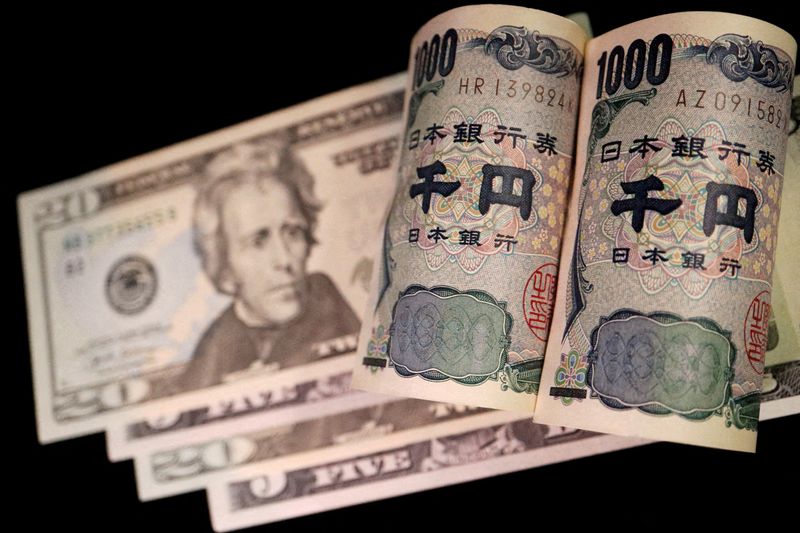
By Stefano Rebaudo
(Reuters) – The yen dropped against the dollar on Tuesday, giving up some of its sharp gains the previous day sparked by suspected intervention by Japanese authorities.
The currency was down 0.35% to 156.90 per dollar, but off its 34-year low of 160.245 hit on Monday when traders say yen-buying intervention by Tokyo drove a eye-catching rebound of nearly six yen.
It briefly dropped earlier in the session and stayed for a couple of minutes at 156.50, before recovering to 157.
Japanese officials may have spent some 5.5 trillion yen ($35.05 billion) supporting the currency on Monday, Bank of Japan data suggested on Tuesday.
“I think the BOJ will now wait for the dust to settle, but the 160 level remains the red line,” said Athanasios Vamvakidis, global head G10 forex strategy at BofA.
“Markets will test that level again, and if the Japanese authorities do not step in, the dollar can go much higher versus the yen,” he added.
The Bank of Japan (BOJ) on Tuesday left its plan for monthly bond buying unchanged for May. Japan’s government bond (JGB) investors are looking for clues on the timing of a taper, which will lead to higher, more attractive yields, supporting the yen.
“Facing that (the rates divergence between Japan and U.S.) with forex intervention typically does not end well,” said Garvey Padhraic, regional head of research Americas at ING.
“The more obvious solution to this is for Japanese rates to rise. If they don’t, something will have to give. And the bigger the hold-out, the bigger is the subsequent reaction,” he added.
remove ads
.
FOCUS ON FED POLICY MEETING
The Federal Reserve begins its two-day monetary policy meeting on Tuesday, where it’s expected to hold rates at 5.25%-5.5%, while striking a hawkish message.
“The Fed policy meeting could be a non-event for the euro/dollar as (Chair Jerome) Powell will not be as dovish as last time, but the market is already discounting such a backdrop by fully pricing just one rate cut in 2024,” Vamvakidis argued.
Traders have recently pared back bets of Fed rate cuts this year amid hotter-than-expected U.S. economic data and stubborn inflation numbers.
A rate cut in September was looking like a close call at just 44%, according to CME Group’s (NASDAQ:) FedWatch tool.
The dollar was down 0.02% to 105.67 against a basket of currencies ahead of the Fed’s meeting, after slipping 0.25% in the previous session.
“Fresh U.S. data has prompted our U.S. economist to push out his projection of the start of the Fed’s easing cycle to 2025 from December 2024,” said Thierry Wizman, global forex and rates strategist at Macquarie.
“We don’t rule out that the next change may be a hike, which would prompt a new wave of broad-based U.S. dollar strength.”
Other major central banks such as the European Central Bank (ECB) and the Bank of England (BoE) may begin to cut rates in the near future, even if the policy path is more uncertain after recent developments.
Euro zone inflation is on its way back to 2%, but the process is bound to be bumpy and geopolitical tensions pose an upside risk to price growth, ECB Vice President Luis de Guindos said late on Monday.
remove ads
.
Data showed that the bloc’s economy rebounded in the first quarter from a mild recession as Germany returned to growth and expansion accelerated elsewhere, while inflation steadied.
The euro fell 0.1% to $1.0731.
The offshore slipped 0.1% to $7.2477 per dollar and has depreciated 2% against the dollar so far this year, despite support from the central bank.
In cryptocurrencies, bitcoin fell 2% to $63,707.00.
($1 = 156.9400 yen)
Forex
Dollar gains ahead of Fed meeting; yen hands back some gains
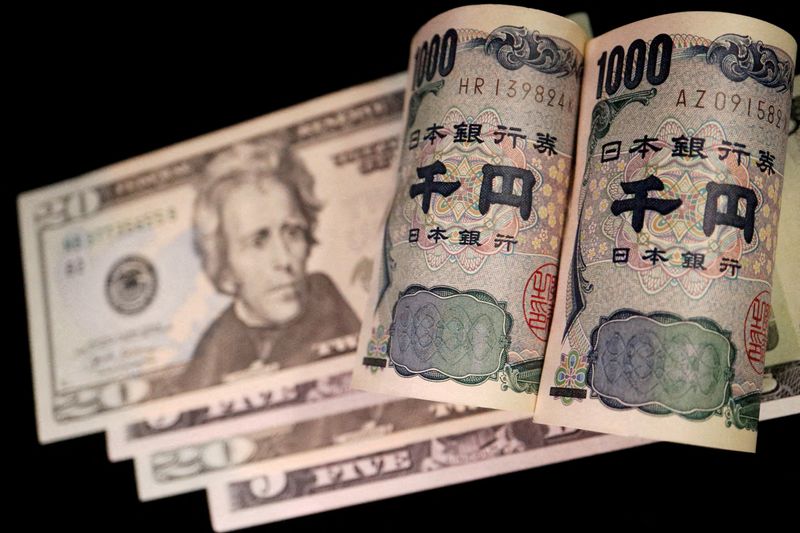
Investing.com – The U.S. dollar climbed higher Tuesday ahead of the start of the latest Federal Reserve policy-setting meeting, while the Japanese yen retreated after suspected intervention.
At 04:40 ET (08:40 GMT), the Dollar Index, which tracks the greenback against a basket of six other currencies, traded 0.3% higher at 105.780, on course for a gain of around 1.4% in April.
Fed meeting looms large
The dollar has generally been in demand this month as a series of hotter-than-expected U.S. inflation readings has resulted in traders pricing out early rate cuts by the .
The U.S. central bank starts its latest two-day meeting later in the session, and is widely expected to keep interest rates at the elevated 5.25%-5.5% levels when it concludes its gathering on Wednesday.
Investors will be awaiting indications about whether the Fed still expects to cut interest rates at some stage this year, having initially expected the first rate cut to come in March, then June and now in September.
Euro struggles despite German retail sales growth
In Europe, fell 0.2% to 1.0702, struggling to make ground against the strong dollar even after the release of data showing rose more than expected in March.
Retail sales increased by 1.8% compared to the previous month, pointing to a recovery in consumption which bodes well for the eurozone’s largest economy, which has just managed to avoid a recession.
Traders are awaiting the release of the latest inflation and growth data for the eurozone as a whole later in the session.
remove ads
.
Preliminary eurozone are expected to have risen 2.4% on the year in April, still marginally above the ECB’s 2.0% medium-term target, while the region is expected to have just 0.1% in the first quarter, growth of just 0.2% on an annual basis.
The has indicated that it is likely to cut its deposit rate in June, but there still exists a great degree of uncertainty over how many other cuts, if any, will be seen this year.
fell 0.2% to 1.2534, retreating in the wake of dollar strength, with sterling set to fall around 0.7% this month.
Yen retreats after suspected intervention
In Asia, rose 0.4% to 156.88, with the yen falling slightly against the dollar after the previous session’s sharp gains that looked like government intervention.
The pair is still way off the 34-year high of 160.245 seen in the previous session.
Japanese officials have refused to confirm intervention to support the yen, but the country’s top currency diplomat Masato Kanda said on Tuesday authorities were ready to deal with foreign exchange matters around the clock.
Mixed Japanese data factored into the yen’s weakness on Tuesday. While rose more than expected in March, missed expectations by a wide margin, presenting a muted outlook for consumer spending and inflation.
traded 0.1% higher to 7.2416 after mixed purchasing managers index data pointed to some slowing in the Chinese economy.
Official data showed activity slowing slightly less than expected, while grew substantially less than expected.
remove ads
.
fell 0.6% to 0.6527, with the Aussie dollar hit by the release of substantially weaker than expected data.
Forex
Asia FX weak as Fed jitters grow, yen stalls after suspected intervention
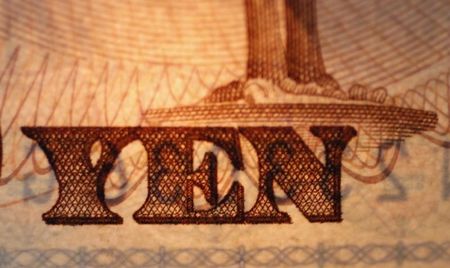
Investing.com– Most Asian currencies fell on Tuesday as anticipation of a Federal Reserve meeting this week kept traders largely biased towards the dollar, with the Japanese yen falling slightly after rebounding amid suspected government intervention.
Most regional currencies were nursing losses through April as traders steadily priced out expectations of early interest rate cuts by the Fed. A series of hotter-than-expected U.S. inflation readings drove this notion.
The and both rose about 0.3% in Asian trade, as investors positioned for the . The central bank is expected to keep rates steady, but could potentially offer hawkish signals in the wake of sticky inflation readings.
Fears of higher-for-longer U.S. rates put the dollar on course for a 1.3% gain in April.
Japanese yen softens, USDJPY rises after tumbling from 160
The pair, which gauges the amount of yen required to buy one dollar, rose 0.3% to about 156.80 on Tuesday.
The pair had fallen sharply from 34-year highs above 160 on Monday, sparking speculation that the Japanese government had intervened to buoy the yen. Traders said it appeared that the new line in the sand for the Japanese government was USDJPY at 160.
While the government gave no official word on the intervention, the yen rebound came after a series of verbal warnings from Japanese officials over the past month.
Mixed Japanese data factored into the yen’s weakness on Tuesday. While rose more than expected in March, missed expectations by a wide margin, presenting a muted outlook for consumer spending and inflation.
remove ads
.
The yen was the worst performer in Asia through April, with the USDJPY pair up nearly 4%.
Australian dollar sinks as weak retail sales dent rate outlook
The Australian dollar was the worst performer in Asian trade on Tuesday, with the pair sinking 0.5% after substantially weaker than expected data.
The reading showed that sticky inflation and high interest rates weighed heavily on consumer spending, which presented a softer outlook for inflation. Traders were seen slashing expectations that the Reserve Bank of Australia will hike interest rates further this year.
The Aussie was set for a muted performance in April.
Chinese yuan weakens on middling PMIs
The Chinese yuan’s pair rose 0.2% on Tuesday after mixed purchasing managers index data pointed to some slowing in the Chinese economy.
Official data showed activity slowing slightly less than expected, while grew substantially less that expected.
While a painted a rosier picture of manufacturing activity, the overall readings still showed limited strength in Chinese business activity.
The USDCNY pair was up 0.3% in April, with further gains constrained by persistent efforts from the People’s Bank.
Other Asian currencies weakened on Tuesday. The South Korean won’s pair rose 0.3%, while the Singapore dollar’s pair added 0.1%.
The Indian rupee’s pair edged closer towards record highs hit earlier in the month, as caution over the 2024 general elections gave the rupee little relief.

 Forex2 years ago
Forex2 years agoForex Today: the dollar is gaining strength amid gloomy sentiment at the start of the Fed’s week

 Forex2 years ago
Forex2 years agoHow is the Australian dollar doing today?

 Forex1 year ago
Forex1 year agoUnbiased review of Pocket Option broker

 Forex2 years ago
Forex2 years agoDollar to pound sterling exchange rate today: Pound plummeted to its lowest since 1985

 Cryptocurrency2 years ago
Cryptocurrency2 years agoWhat happened in the crypto market – current events today

 World2 years ago
World2 years agoWhy are modern video games an art form?

 Stock Markets2 years ago
Stock Markets2 years agoMorgan Stanley: bear market rally to continue

 Economy2 years ago
Economy2 years agoCrude oil tankers double in price due to EU anti-Russian sanctions

